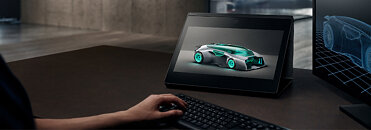Thursday, October 15th 2020

Sony Electronics Launches Groundbreaking Spatial Reality Display
Sony Electronics Inc. today announced the debut of the Spatial Reality Display (SR Display), a groundbreaking new product made with Sony's award-winning Eye-Sensing Light Field Display (ELFD) technology. The display, initially shared with attendees at the Consumer Electronics Show in January of this year, does not require virtual reality glasses or a headset. The SR Display enables creators across a variety of industries, from automotive and industrial design, to Computer Graphics (CG) and Visual Effects (VFX) designers and creators in film to bring ideas to life in stunning 3D displays.
"We're excited to bring the world's best technology to bear, moving the design and creation industry forward, particularly as the shift to digital has become so pronounced," stated Mike Fasulo, president and chief operating officer of Sony Electronics North America. "This technology drives new versatility, allowing us to advance an entirely new medium and experience for designers and creators everywhere."Extraordinary 3D Image Quality
Using spatial reality to combine the virtual and physical world, the Spatial Reality Display creates an incredible 3D optical experience that is viewable to the naked eye. This is made possible by several technologies:
Sony's dedicated SDK makes it easy for designers to create content for the SR Display.4 The SDK is compatible with industry-standard tools Unity and Unreal Engine, so creators can work within an already-familiar production environment, and can be used to develop interactive applications in gaming, VR, construction, and automotive design. Please visit the SR Display developer site for more info: https://www.sony.net/dev-srd.
Applications for Content Creators Across Industries
For filmmakers, graphic artists, engineers and product designers in corporate and industrial settings, the cutting-edge 3D visual technology of the SR Display delivers a futuristic, yet highly practical visual experience, where detailed colors, textures, contrasts and brightness fuse, to form a new medium for image, character and product design and visualization.2 For example, in the automotive industry, there is potential to integrate the product early on in the new vehicle design ideation process, improving quality, speed and the tangible nature of the concepts themselves.
"At Volkswagen, we've been evaluating Sony's Spatial Reality Display from its early stages, and we see considerable usefulness and multiple applications throughout the ideation and design process, and even with training," commented Frantisek Zapletal, Virtual Engineering Lab US, Volkswagen Group of America, Inc. "We're excited to continue blazing trails and collaborating with Sony to find practical use cases for this innovative product at Volkswagen."
To highlight the capabilities of this cutting-edge technology, Sony Electronics collaborated with Sony Pictures Entertainment and Columbia Pictures subsidiary Ghost Corps on the upcoming Ghostbusters film, "Ghostbusters: Afterlife," scheduled for release in 2021. The collaboration focused on using the SR Display to bring both familiar and new film characters to life, through the groundbreaking visual medium.
"We have been working with the Sony team to bring Ghostbusters characters and assets to life using Sony's Spatial Reality Display," noted Eric Reich, brand and franchise executive at Ghost Corps. "Moving forward, we could see potential benefits from pre-visualization to 3D modeling. The display offers a new approach to visualizing concepts and characters, making understanding the finished product that much easier."
Pricing and Availability
The SR Display has a suggested retail price of $4,999.99 USD and $6,649.99 CAN. It will be available to order on Sony's direct e-commerce site and other retailers in November.
For more information, visit the product page.
"We're excited to bring the world's best technology to bear, moving the design and creation industry forward, particularly as the shift to digital has become so pronounced," stated Mike Fasulo, president and chief operating officer of Sony Electronics North America. "This technology drives new versatility, allowing us to advance an entirely new medium and experience for designers and creators everywhere."Extraordinary 3D Image Quality
Using spatial reality to combine the virtual and physical world, the Spatial Reality Display creates an incredible 3D optical experience that is viewable to the naked eye. This is made possible by several technologies:
- High-speed Vision Sensor - The SR Display is based an innovative high-speed vision sensor which follows exact eye position in space, on vertical, horizontal and depth axes simultaneously. The display monitors eye movement down to the millisecond, while rendering the image instantaneously, based on the location and position of the viewer's eyes. This allows creators to interact with their designs in a highly-realistic virtual, 3D environment, from any angle without glasses.
- Real-time Rendering Algorithm - Additionally, the SR Display leverages an original processing algorithm to display content in real-time. This allows the stereoscopic image to appear as smooth as real life, even if the viewer moves around.
- Micro Optical Lens - The micro optical lens is positioned precisely over the stunning 15.6 inches (diag.) LCD display. This lens divides the image into the left and right eyes allowing for stereoscopic viewing with just the naked eye.
Sony's dedicated SDK makes it easy for designers to create content for the SR Display.4 The SDK is compatible with industry-standard tools Unity and Unreal Engine, so creators can work within an already-familiar production environment, and can be used to develop interactive applications in gaming, VR, construction, and automotive design. Please visit the SR Display developer site for more info: https://www.sony.net/dev-srd.
Applications for Content Creators Across Industries
For filmmakers, graphic artists, engineers and product designers in corporate and industrial settings, the cutting-edge 3D visual technology of the SR Display delivers a futuristic, yet highly practical visual experience, where detailed colors, textures, contrasts and brightness fuse, to form a new medium for image, character and product design and visualization.2 For example, in the automotive industry, there is potential to integrate the product early on in the new vehicle design ideation process, improving quality, speed and the tangible nature of the concepts themselves.
"At Volkswagen, we've been evaluating Sony's Spatial Reality Display from its early stages, and we see considerable usefulness and multiple applications throughout the ideation and design process, and even with training," commented Frantisek Zapletal, Virtual Engineering Lab US, Volkswagen Group of America, Inc. "We're excited to continue blazing trails and collaborating with Sony to find practical use cases for this innovative product at Volkswagen."
To highlight the capabilities of this cutting-edge technology, Sony Electronics collaborated with Sony Pictures Entertainment and Columbia Pictures subsidiary Ghost Corps on the upcoming Ghostbusters film, "Ghostbusters: Afterlife," scheduled for release in 2021. The collaboration focused on using the SR Display to bring both familiar and new film characters to life, through the groundbreaking visual medium.
"We have been working with the Sony team to bring Ghostbusters characters and assets to life using Sony's Spatial Reality Display," noted Eric Reich, brand and franchise executive at Ghost Corps. "Moving forward, we could see potential benefits from pre-visualization to 3D modeling. The display offers a new approach to visualizing concepts and characters, making understanding the finished product that much easier."
Pricing and Availability
The SR Display has a suggested retail price of $4,999.99 USD and $6,649.99 CAN. It will be available to order on Sony's direct e-commerce site and other retailers in November.
For more information, visit the product page.

10 Comments on Sony Electronics Launches Groundbreaking Spatial Reality Display
For $5,000, it better damn be Adobe RGB 100% and at least 2160p.
"uses a microlens array to split an image into individual light rays. Using adequate encoding of the image shown, the display can create a light field directly in front of the viewer’s eyes, who can then focus on the various depths of a scene. "
lightfield-forum.com/light-field-camera-prototypes/nvidia-near-eye-light-field-display/
Suffice to say, this technology is a huge step forward and should become standard once the price comes down. If you've ever experienced VR before, it's like that but slightly better and zero nausea.
You can also see this technology has been demoed for use with VR as well here: www.roadtovr.com/creal3d-light-field-display-ar-vr-ces-2019/
If i had $5k to piss up the wall, i would buy one to piss about with
I blame human creativity... or should I say urges